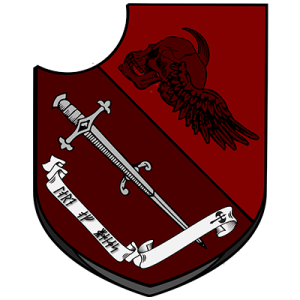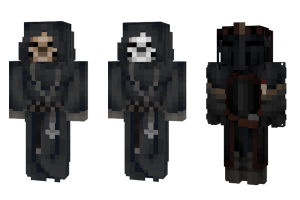The Cult of Mortius
|
| Black Abbot | Raymond van der Draeck |
| Seat of Power | Königstein |
| Territory | The Krönlanden |
| Major Festivals | Geistertag, Hexensnacht |
| Primary Religion | Alderism |
| Holy Sites | Fields of Mortius, Monasteries of Mortius |
| Active in | The Hadrian Empire |
Overview
The Cult of Mortius is among the most ancient and widespread cults in Western imperial lands. In realms plagued with constant conflict and horrors from beyond the veil, death is a constant inescapable companion of most mortals. It is when a mortal meets death when they are brought to the sanctums of Mortius to make the crossing across the veil towards The Halls of Divinity. Cultists of Mortius are both caretakers of the deceased and guardians of their bodies that are kept buried in the plains of Mortius all across the Empire and beyond. During the day the cultists prepare the bodies for burial rituals that are to be carried out at dawn, and during the nights, they roam the fields of Mortius, wearing dark steel armour and wielding silver blades to ward off graverobbers, necromancers, and vampires who prey on the remnants of the dead. Those who are not on grave watch, watch over the dying in their homes, praying for safe passage with the family before the inevitability of death catches up with the dying mortal.
The priests, or cultists, worship the sentinel named Mortius above all. They have accepted death as a necessary thing for all and have made it their task to guide the more weak-minded mortals along the path of acceptance, to live without fear of death for it is inescapable, and guard over them as Mortius’ custodians after their passing. Many people fear the cultists of Mortius as they seem to live completely separate from mortal society. They only care for those that are dead or nearing death. They live secluded lives surrounded by corpses and the insignia of death in shacks or small monasteries close to the plains of Mortius, only coming out to provide guidance to mourning families, take care of bodies, or guard the dead from Necromancers who are deemed the ultimate enemy of Mortius for they disrupt the natural cycle of life and death.
Appearance & Lifestyle
Cultists of Mortius are easily recognizable, even by the untrained eye for they stand out like a black crow on a roof filled with white doves. They wear long unornamented black robes with black hoods that have no indication of rank or personality, strung together with black belts decorated by either a silver arrow tip or skull. They are all deemed anonymous when on duty and therefore always wear a silver skull mask outside their homes. When the cultists are on grave watch, they wear black plated armor over their cloaks, most of the time only wearing gauntlets and a chest, and back plate. Their belt is outfitted with a silver longsword which they use to strike down anyone who dares to disrupt the dead. As a sidearm, most cultists wear a normal or hand crossbow with a handful of silver-tipped arrows. During rituals, some of the cultists are seen carrying a ritualistic scythe while riding a black horse decorated with similar black robes and belts as the cultist. Most cultists grow their beards long but well-kept. Their hairstyles vary but most of the time they keep it long straight hair, some even go as far as to dye it black. Female cultists, though rare, do exist. They too keep their hair long and straight and do not differentiate at all from their male counterparts in terms of outfit.
To join the cult of Mortius one has to abandon all their mortal bonds as they are expected to fully commit themselves to their new tasks as caretakers of the dead, a duty where mortal bonds have no place. There is no way out of priesthood when joined except a singular route for the female cultists, for when they find themselves pregnant, they were given a new task as caretakers of new life and therefore cannot serve the dead exclusively any longer. Even though a cultist is expected to abandon their lives before they join, it does not exclude them from any social interaction at all. Cultists of Mortius are a closely knit community within the greater Temple of Alder and share many activities with one another such as game nights, banquets, hunting events, and more. In some rare instances, cultists form a romantic relationship with one another. Even though it is frowned upon, it is not forbidden for it is seen as only part of the natural way of the cycle of life and death to seek a romantic companionship.
Beliefs
The fundamental belief of every cultist of Mortius is that death is inevitable, and should never be, and that they are Mortius’ custodians to ensure the natural order is preserved, taken care of, and protected against those who may wish to disrupt this order. The only essence of the mortal being that matters to the cultists is the soul, which they assist in carrying on to the afterlife through burial rites and placing protective wards against necromantic or vampiric influences.
Fundamental Strictures of the Cult
- Protect the plains of Mortius at all costs.
- Watch over the mourning and guide them forward.
- Destroy any influence that disrupts the natural cycle of life and death.
- Watch over any funeral and ensure the correct rites are carried out and the wards are placed.
- Burn all bodies that have been defiled by a necromancer before reburying the ashes.
Holy Sites
The monasteries of Mortius are grim and dark buildings. Most often constructed of deep slate stone and decorated with darker-colored woods for their doors and windows. The glass in the temples is tinted and often decorated with stained glass depictions of Mortius or tales of his legend. These monasteries are often placed on hills surrounded by the so-called plains of Mortius, big open fields where the dead are buried and protected from necromancers by the cultists of Mortius. The fields are fenced off and statues of Mortius are seen on every corner to ward off any potential intruder. The buildings inside the plains are also built of deep slate stone and decorated with silvered skulls and spikes, representing the arrow tips that are a common sight within the cult.
Every monastery of Mortius is topped off with a big bell tower that is only used during funerals, or during attacks on the location by the undead. The tower itself is decorated by both again statues of Mortius and gargoyles depicting all sorts of skeletal entities.
The monasteries are both the working and living places for the cultists of Mortius and they spend most of their time there. There are usually small crop fields, animal pens, and herb gardens inside the inner gardens that the cultists cultivate to feed themselves. The remainder of the monastery includes dorm rooms for male and female cultists, a common room, a chapel to Mortius, a ritual chamber where bodies are prepared for the funeral, a medical ward for the sick, a dining hall and kitchen, a mason where gravestones are made, an armory and tailor, and a granary where food is stored. Below the monastery usually lies a separate crypt where cultists are buried.
Burial Rites and Wards
The cultists of Mortius are present at any funeral within the realms they operate in. They are active throughout the entire process from the last days of the person to the moment the coffin gets lowered into the grave. The most important task of this process is handling the burial rites and placing a protective ward on the body to protect it against necromantic influences. What is usually done is that while the body is prepared for the funeral, a cultist of Mortius plants a silver stake decorated with a silver skull pommel inside the deceased’s chest and through the heart to ward it from necromantic resurrection. After this is done, a prayer to Mortius is conducted, asking for Mortius’ safe passage into the Halls of Divinity. This prayer is then repeated at the funeral itself right before the coffin is lowered into the grave on the field. After this has been done and the coffin is lowered into the grave, the priest of Mortius and companions immediately seal the grave with dirt and plant a flower of choice on the grave. Gravestones are placed beside the grave shortly after. Some are as simple as a small plaque, others are more extravagant. What gravestone is placed only depends on the funds of the family who bury their dead. If no gravestone can be paid for, the cult donates a small plaque to the family so that the name of the dead is not forgotten.


